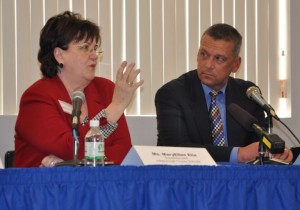Florida’s new education commissioner is known for his zealous support of charter schools and vouchers and other learning options that some critics see as anti-public school.

But on Tuesday afternoon, Tony Bennett sat next to Hillsborough County Public Schools Superintendent MaryEllen Elia inside a Tampa magnet school for boys, and praised the growth of choice in district schools across the state.
Florida is transcending the first round of conversations on choice that pit private and charter schools against public schools and virtual schools against “brick and mortar’’ ones, Bennett said during an event marking National School Choice Week. The new conversation, he suggested, isn’t either-or; it’s whatever works to ensure all kids have access to quality choices.
“So we’re now talking about choice – not just private schools and charter schools and virtual schools – we’re talking about public school choice,” he told an audience of about 100 people gathered at the Boys Preparatory Academy. “We’re talking about creative leaders like MaryEllen, like the team here, creating educational opportunities for children within the district – and really going to what we all heard was the purpose of choice to begin with, to provide incubation for innovation for our public schools.”
Tuesday’s event was sponsored by the Florida Alliance for Choices in Education, a coalition that includes a wide swath of school choice groups. Bennett and Elia sat on a panel with representatives from home-schooling, virtual education, magnet schools, career academies, Florida tax credit scholarships and McKay scholarships.
Most were parents who had lived and breathed school choice, starting with their own children. As they shared stories of searching for schools that practiced their faith or fit their child’s academic needs, they offered numbers that shed light on the choice movement’s impact.
About 43 percent of students in Florida now go to a school other than the one they’re zoned for, according to Florida Department of Education data. That includes more than 240,000 in magnet schools, 200,000 in charter schools, 137,000 in career academies and 50,000 who use tax credit scholarships to help pay private school tuition. (The latter program is administered by Step Up For Students, which is a member of FACE and co-hosts this blog.)
“The Florida choice framework is one of a national model,’’ Bennett said. “It’s one where a state has embraced the social justice of providing all children an opportunity to go to school and live the American Dream.’’
Hillsborough is a good example of what’s been quietly happening at the district level.
Hillsborough opened its first magnet school in 1991, when Elia was the district’s magnet supervisor. Now there are more than 35, with 50,000 of the district’s nearly 200,000 students enrolled. Hillsborough also was among the first districts to embrace charter schools, and now has 43 with the number expected to grow to 50 next fall.
“The big issue is, no child is the same,’’ Elia said. These children are all our children, she said, and no matter the option “we have to do everything we can to make them successful.’’
Bennett said it doesn’t really matter anymore where children go to school, he said. It matters if they are well-prepared.
“Our goal is to make sure that all choices are quality choices,’’ he said.


